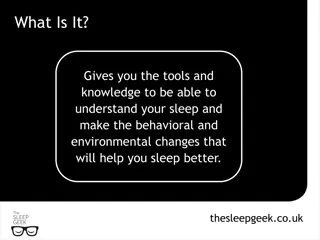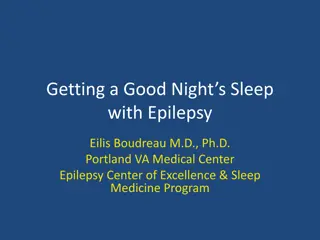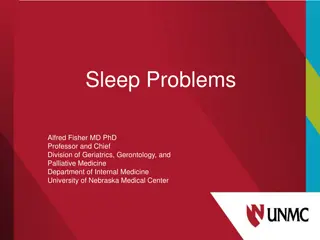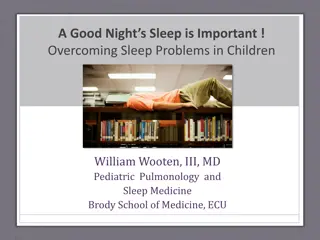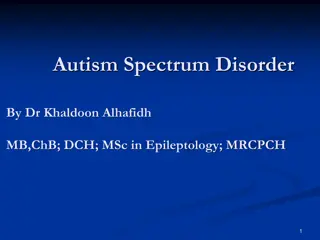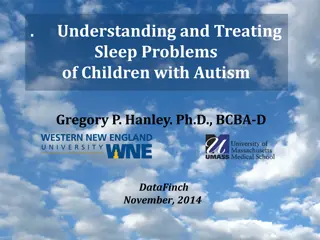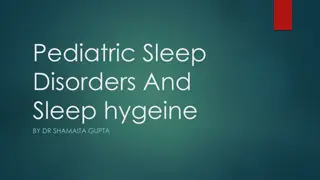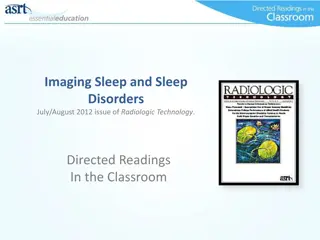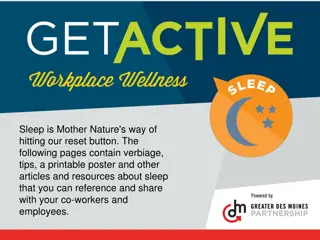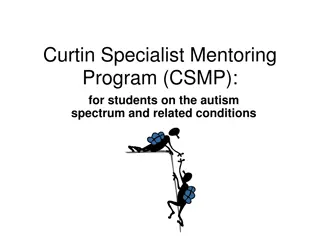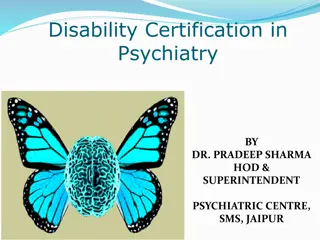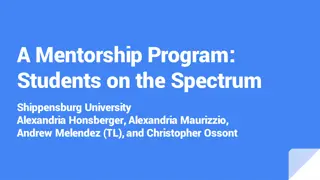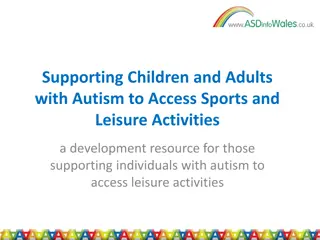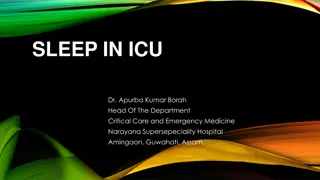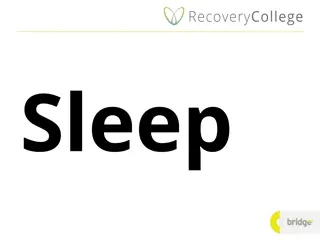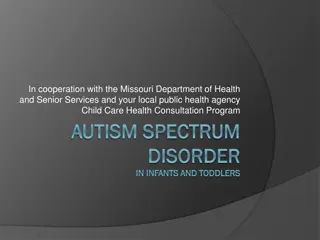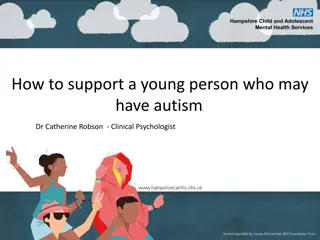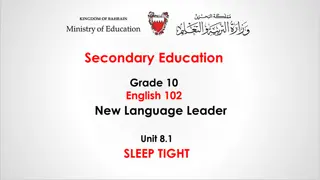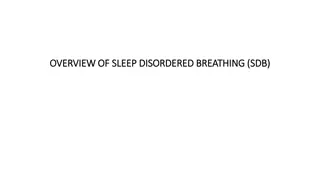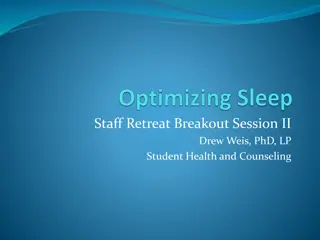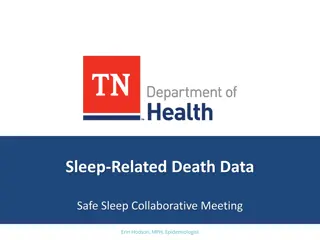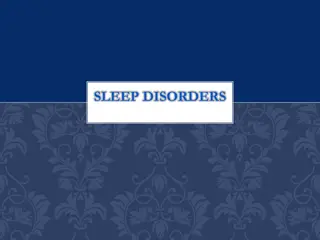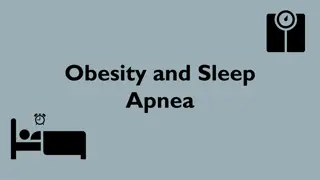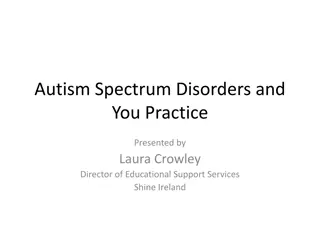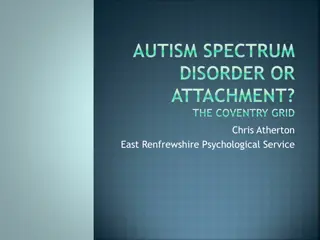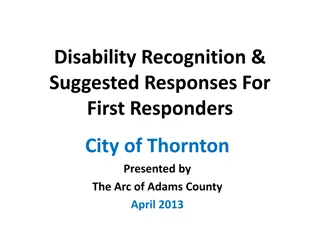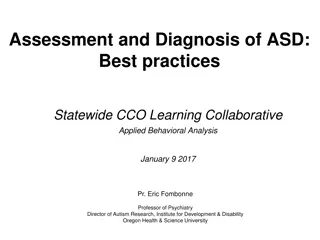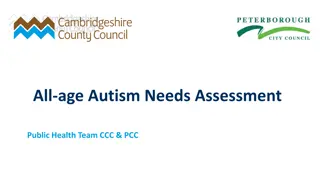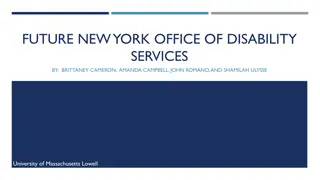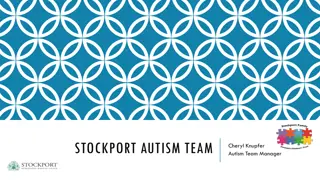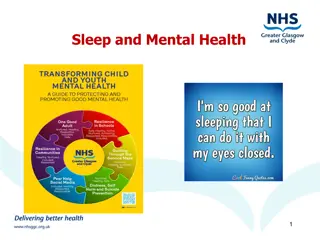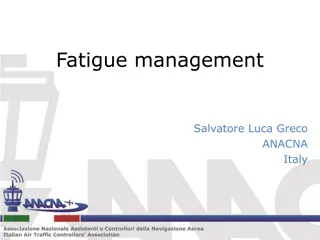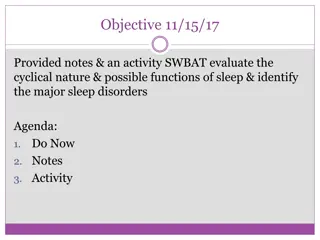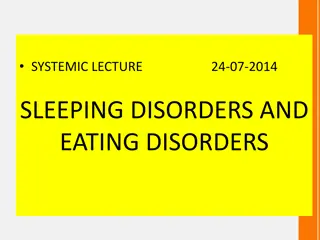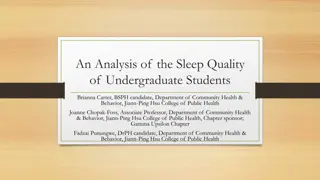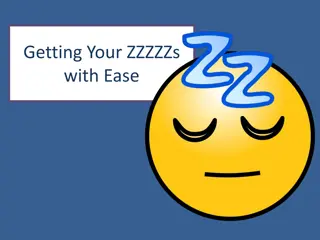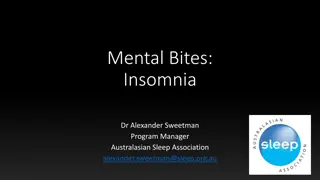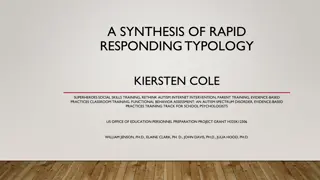Understanding Sleep Phenotypes in Autism Spectrum Disorder
Sleep disturbances in individuals with Autism Spectrum Disorder (ASD) vary from delayed sleep onset to difficulties waking up. Lack of proper sleep exacerbates core ASD symptoms and affects overall well-being. The importance of addressing sleep health in ASD is highlighted, as chronic sleep disturbances persist into adulthood. Research from Sleep Research & Treatment Center sheds light on the impact of sleep on ASD symptoms and the need for specific sleep management strategies. The Tale of Two Clinics compares data from psychiatric outpatient diagnostic clinics and sleep medicine clinics, emphasizing the significance of studying sleep in ASD populations.
Download Presentation

Please find below an Image/Link to download the presentation.
The content on the website is provided AS IS for your information and personal use only. It may not be sold, licensed, or shared on other websites without obtaining consent from the author. Download presentation by click this link. If you encounter any issues during the download, it is possible that the publisher has removed the file from their server.
E N D
Presentation Transcript
Sleep Phenotypes in Autism Spectrum Disorder: Too Aroused to Sleep, Too Delayed to Wake Up Spectrumnews.org Susan L. Calhoun, Ph.D., ABPP Associate Professor of Psychiatry Sleep Research & Treatment Center Penn State College of Medicine Hershey, PA
Outline Sleep health Development Impact Phenotypes Treatment Conclusions
Importance of Sleep Health Sleep is one of the most important restorative behaviors for children and adolescent s health and well-being. Sleep promotes growth. Sleep helps the heart. Sleep helps maintain a healthy weight. Sleep helps beat germs. Sleep boosts learning and memory. Sleep increases attention span. Sleep regulates mood. Sleep deprivation in this country is an public health epidemic!
What our local gas station has to offer... Photo courtesy of Dr. Fernandez-Mendoza (Hershey, PA)
Importance of Sleep Health in ASD Some sleep disturbances are developmental, like those found in neuro-typical peers but in youth and young adults with ASD More often chronic and persist through adolescence into adulthood. Can exacerbate the severity of core ASD symptoms: repetitive behaviors, stricter adherence to non-functional routines, social and communication difficulties and other maladaptive behaviors such as self-injury or aggression One of the least studied aspects of ASD, despite highly reported Treatment guidelines typically do not mention specific management of sleep. Often experience coexisting sleep disturbances such as difficulty falling and staying asleep or sleeping late into the day (i.e., phenotypes).
The Tale of Two Clinics Psychiatry Outpatient Diagnostic Clinic Clinical Cohort (2-17y, N=4,000), of whom 1,500 diagnosed with ASD Parent-reported sleep variables: 9 items from sleep subscale and daytime sleepiness from the Pediatric Behavior Scale (PBS) Sleep Research & Treatment Center (SRTC) Multidisciplinary sleep medicine clinic with a behavioral sleep medicine (BSM) program Penn State Child Cohort Population based random sample Baseline (5-12y, N=700), 1st follow-up (12-23y, N=421), and ongoing 2nd follow-up (20-30y, target N=500) Parent-reported sleep variables (PBS, Pediatric Sleep Questionnaire etc.), in-lab 9-hour polysomnography (PSG) and at-home 7-day actigraphy (ACT)
Frequency and Types of Sleep Problems Children 6-16 years Difficulty falling asleep Restless during sleep Wakes often at night Nightmares Talks or walks in sleep Wets bed Wakes up too early Sleeps less than normal Sleeps more than normal Daytime sleepiness Controls 41% 48% 36% 44% 35% 10% 24% 12% 16% 12% ASD 61% 51% 39% 52% 33% 29% 42% 45% 13% 26% ADHD-C 48% 47% 38% 42% 36% 21% 31% 24% 13% 12% ADHD-I 40% 34% 24% 26% 28% 10% 22% 19% 17% 24% ANX/DEP 55% 48% 38% 40% 30% 7% 17% 15% 27% 30% TBI 39% 36% 24% 30% 30% 21% 21% 21% 21% 21% (Mayes, Calhoun, Bixler, Vgontzas et al, Sleep Medicine Clinics 2009, 4, 19-25)
Developmental Trajectories: Greater Vulnerability in ASD Childhood Night terrors Behavioral insomnia of childhood DFA need of caregiver and/or bedtime resistance Adolescence Those chronic since childhood DFA with inability to sleep enough when given adequate sleep opportunity( too aroused to sleep ; chronic insomnia) Those typical new onset Circadian shift towards eveningness ( too delayed to wake up ; circadian disorder) DFA remains but for different reasons, resulting in daytime sleepiness
Developmental Trajectories (Mayes, Puzino, DiGiovanni, Calhoun, submitted)
Nuances of Sleep Behavior There are specific aspects in youth with ASD that negatively affect their sleep. Social cueing problems: May not make the connection between others going to bed and their own need to sleep. Impaired social skills: Complicate the establishment of social interactions and affect scheduled social-behavioral input to the circadian system. Sensory differences: Hyper-reactivity to blue light from screens or bright light avoidance. Sensitivity to certain sounds, which may be upsetting or distracting and keep them awake. Rigidity in routines: Difficulty transitioning to bed, inability to adapt to changes in sleep schedule. Physical or mental health problems: GERD, seizures, ADHD, and anxiety and medication side effects can all play a role in sleep disturbances in this population
Impact of Sleep Disturbances On physical, emotional, cognitive and social development of people with ASD and negatively affects family members overall quality of life. Especially true in adolescence and young adulthood which is a critical period for the impact of sleep disturbance on daytime functioning, psychosocial adaptation and community and occupational participation.
Impact of Sleep Disturbances Sleep Disturbance (Calhoun, Pearl, Fernandez-Mendoza, Durica, Mayes, Murray, JADD 2019)
Impact of Sleep Disturbances 70 75 Sleep Disturbances T-Score Sleep Disturbances T-Score 70 65 65 60 60 55 55 50 50 45 45 40 40 35 35 30 30 25 30 35 40 45 50 55 60 65 70 75 25 30 35 40 45 50 55 60 65 70 75 Physical Health T-Score Depression T-Score 70 75 75 Sleep Impairment T-Score Sleep Impairment T-Score Sleep Impairment T-Score 70 70 65 65 65 60 60 60 55 55 55 50 50 50 45 45 45 40 40 40 35 35 35 30 30 30 25 30 35 40 45 50 55 60 65 70 75 25 30 35 40 45 50 55 60 65 70 75 25 30 35 40 45 50 55 60 65 70 75 Physical Health T-Score Anxiety T-Score Depression T-Score Physical health was significantly associated with sleep disturbance (r=-.29, p=.03) and sleep- related impairment (r=-.42, p<.01) Anxiety was significantly associated with sleep disturbance (r=.30, p=.03) and sleep-related impairment (r=.42, p<.01) Depression was significantly associated with sleep-related impairment (r=.45, p<.001), but not sleep disturbance (r=.20, p=.14) Essayli J, Pearl A, Calhoun S, Fernandez-Mendoza J, Murray M, ABCT
Sleep Disturbance Phenotypes Insufficient Sleep Behaviorally-driven problem of inadequate time in bed to obtain age-appropriate sleep duration <10h (3-6y), <9h (7-12y), <8h (13-17), <7h (18-age) Chronic Insomnia ( too aroused to sleep ) Difficulty falling or staying asleep (and/or waking up too early, less common) Psychophysiological issue (sleep physiology + sleep behavior): hyperarousal Despite adequate opportunities/circumstances for sleep, including timing Circadian Disorder ( too delayed to wake up ) Clock-driven problem of inadequate timing of sleep, typically delayed Misalignment between biological clock and psychosocial schedule
Circadian Preference Night Owls Late phenotypes or night owls naturally sleep later, around 1 to 4 am, and wake up later, around 9 to 12 pm, with highest alertness and energy in the morning Early Birds Early phenotypes or lark or rooster naturally go to sleep earlier, around 9 to 10 pm, and wake earlier, around 4 to 6 am, with highest alertness and energy in the late evening.
Circadian Disorders In-phase Advanced Common in youth w/ ASD (23%) Delayed Irregular Uncommon in youth Most common in: Elderly Persons with acquired or congenital blindness Non 24-h 4pm 8pm Midnight 4am 8am Noon 4pm
Too Delayed to Wake Up Typical hormonal secretion of the sleep-wake cycle Image result for sleep rhythm In circadian disorders not only the sleep-wake schedule is out of sync but also the hormonal secretion aligned with it (pathophysiology) as well as other physiological needs and behaviors (e.g., eating)
Importance of Assessing Ad-Libitum Sleep Sleep Diary EXAMPLE 01/01/2019 2 Today's date: 1a. How many times did you nap? 1b. In total, how long did you nap? 2. What time did you get into bed? 3. What time did you try to go to sleep? 4. How long did it take you to fall asleep? 5. How many times did you wake up during the night? 6. In total, how long did these awakenings last? 7. What time did you wake up in the morning? 8. What time did you get out of bed for the day? 9. In total, how long did you sleep? 10. How would you rate the quality of your sleep? Actigraphy Device 1 hour 10:30 pm 11:30 pm 1 hour 6 times 2 hours 6:30 a.m. 7:00 a.m. 4 hours Very poor Poor Fair Good Very good Yes No Medication: Relaxo-Herb Very poor Poor Fair Good Very good Yes No Medication: Medication: Very poor Poor Fair Good Very good Yes No Yes No Medication: Very poor Poor Fair Good Very good Very poor Poor Fair Good Very good Yes No Medication: Medication: Very poor Poor Fair Good Very good Yes No Yes No Medication: Very poor Poor Fair Good Very good Very poor Poor Fair Good Very good Yes No Medication: 11. Did you take any over-the- counter or prescription medication to help you sleep? Dose: 50 mg Time: 11 pm Dose: Time: Dose: Time: Dose: Time: Dose: Time: Dose: Time: Dose: Time: Dose: Time:
Treatment of Delayed Sleep Phase Morning bright light exposure Therapy lamp of 10,000 lux, start at 1 hour before ad-lib wakeup time (e.g., 11:00 am) Expose for at least 60 minutes Advance wake time by 30 minutes daily until target reached (e.g., 10:30 am 7:00 am) Evening bright light blocking Orange-tinted glasses: commercially available blue light blocking glasses Educate on OTC timed melatonin 0.5mg, 4 hours before desired sleep onset Advance bedtime by 30 minutes nightly until target reached (e.g., 10:00 pm 6:00 pm) Sleep behavior modification Stimulus control: 20-minute rule to combat DFA (get out of bed and do something boring) Reduce sleep-incompatible (e.g., using smartphone in bed) and sleep-compensatory behaviors (e.g., napping) Circadian preference modification Change in evening lifestyle : limit electronic use 60-90 minutes before desired bedtime, planned morning activities of interest
Treatment for Delayed Sleep Phase Baseline Day 1 Day 2 Day 3 Day 4 Day 5 Day 6 4pm 8pm Midnight 4am 8am Noon 4pm
Too Aroused to Sleep Chronic insomnia is a disorder of hyperarousal throughout the 24-hours that is conditioned to the sleep environment. Characterized by: Becoming too alert or anxious as bedtime approaches. Physiologic activation (e.g., increased cortisol, heart rate) in the evening. Dozing off in other rooms (e.g., watching TV) but unable to fall asleep once in own bed. Racing mind at bedtime, including worry about not sleeping. Staying in bed trying hard to sleep or engaging in sleep-incompatible behaviors. Inability to nap during day, despite desired. A highly frequent disorder: ~28% late adolescents and young adults with ASD vs. 10% general population Autism Treatment Network and American College of Physicians recommend: Cognitive behavioral therapy for insomnia (CBT-I) as first-line treatment, however, pharmacotherapy is standard
Treatment of Insomnia in ASD Sleep Education General education on sleep and insomnia Sleep Hygiene Behavioral Therapies Sleep Restriction: based on sleep efficiency (i.e., total sleep time/time in bed) calculated from weekly sleep diary; set wake up time Stimulus Control: 20-minute rule to combat DFA, reduce sleep-incompatible and sleep- compensatory behaviors Cognitive Therapies Planned Worry to decrease cognitive hyperarousal Adaptations Inclusion of caregivers Focus on the B in CBT-I: highly effective, evidence-based techniques. Adapt the C in CBT-I: to different levels of intellectual ability and personal motivation
Treatment of Insomnia in ASD Session 1 New/Review* N Content Max. duration Weeks Sleep Restriction Stimulus Control Troubleshooting Sleep Hygiene Troubleshooting Planned Worry Troubleshooting 60 min 0 week R N R N R 2 60 min 1 week 3 60 min 2 weeks 4 60 min 3 weeks R N R Troubleshooting Cognitive Education Troubleshooting 5 60 min 4 weeks 6 60 min 5 weeks R N R Troubleshooting Relapse Prevention Troubleshooting 7 60 min 6 weeks 60 min 8 7 weeks
Conclusions Identification Systematic screening and assessment of potential co-occurring sleep problems among youth with ASD is mandatory. Sleep problems are not only frequent but, most importantly, persistent. They are unlikely to resolve with age for over half the youth with ASD. Knowledge of developmentally appropriate sleep changes is important. Access to health services decreases during the transition from adolescence to adulthood and chronic sleep disorders are likely to be unattended to in these age groups. Untreated sleep disorders impact daytime functioning and impede participation in valuable activities such as education, employment and community participation. Phenotyping Insomnia or delayed sleep phase? Underlying circadian disorder is often misdiagnosed and treated as chronic insomnia. Clinicians should become more proficient in differentiating, at least, these two conditions. These phenotypes have direct implications for treatment, despite often receiving the same treatment (e.g., sleep medication). Consider referrals to sleep centers or incorporate sleep clinicians as part of ASD groups / consultation.
Conclusions Treatment First-line treatment for chronic insomnia should be CBT-I. First-line treatment for delayed sleep phase should be light therapy (exposing and blocking) and, as adjunct therapy, low-dose timed melatonin. Future directions: Little evidence to help guide treatments in persons with ASD. CBT-I is well-established in neurotypicals but not in those with ASD. We need large clinical trials on the effectiveness of CBT-I vs. sleep medication in persons with ASD. Do we need to tailor treatments (e.g., CBT-I, circadian) to persons with ASD and their specific sleep phenotypes? Non-pharmacological approaches, including CBT-I and bright light therapy, must consider the views of persons with ASD and take a patient-centered approach. Need for clinical trials using a decision-making approach: based on treatment response. As some people with ASD may need both behavioral and pharmacological treatments, we need to know which should come first? These future directions require multidisciplinary collaborations across disciplines and fields.


